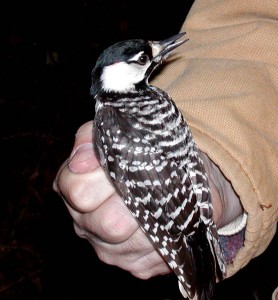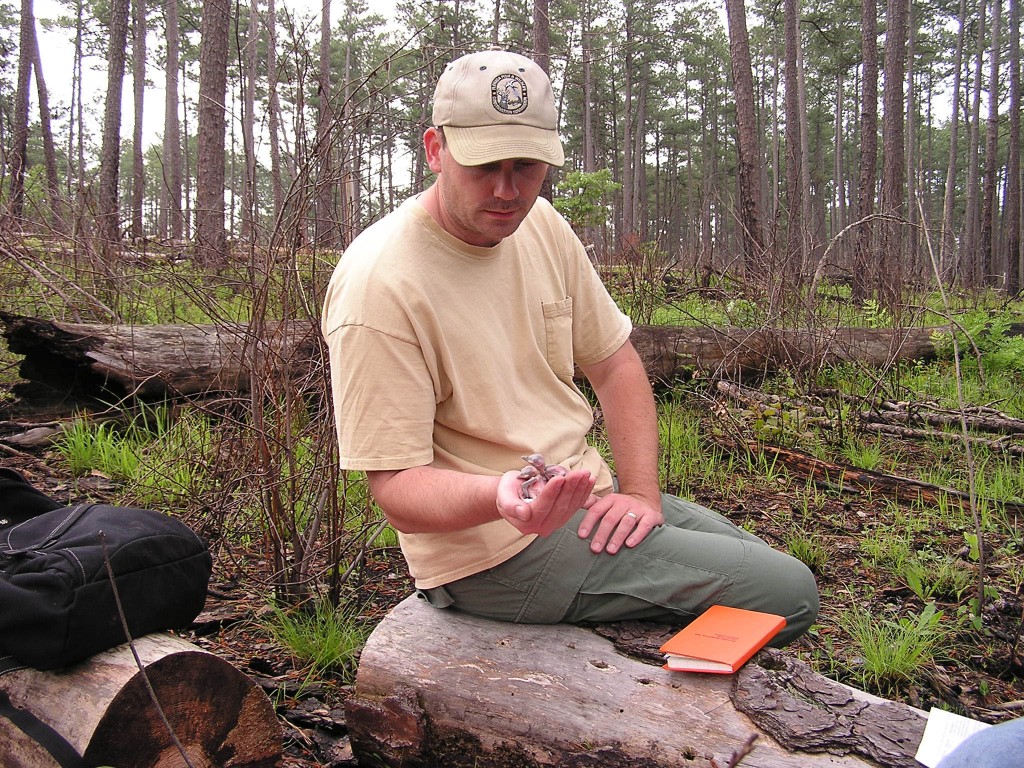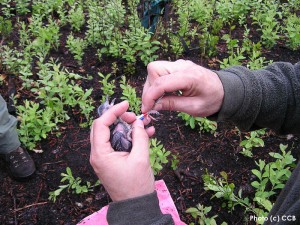CCB continues work with endangered Red-cockaded Woodpecker
Aerial surveys for cliff-nesting birds extends into the southern Appalachians
June 14, 20082007 Golden-winged Warbler Results
June 16, 2008
Written by Michael Wilson
June 15, 2008

Adult red-cockaded woodpecker. Photo by the Center for Conservation Biology.
The 2008 red-cockaded woodpecker nesting season at the Nature Conservancy’s Piney Grove Preserve had both high points and low points. The annual spring survey conducted by the Center for Conservation Biology in April documented 7 active cluster sites that supported a combined 26 individual red-cockaded woodpeckers (RCW). This is the highest number of red-cockaded woodpecker clusters known in Virgnia since the late 1980s, when the population was in drastic decline. All seven active clusters documented this spring were occupied by at least one adult male and one adult female giving each the potential to breed in 2008. We have seen the number of potential breeding clusters grow by one cluster each year over the last four years.
RCWs are cooperative breeders so the term ‘breeding cluster’ is used to describe a red-cockaded woodpecker breeding site because it can contain a group of individuals including the resident breeding pair and sometimes additional non-breeding helper birds that assist in feeding young or excavating cavities.

The Center for Conservation Biology researcher, Michael Wilson, holding a pair of RCW chicks at Piney Grove Preserve, VA. Photo by the Center for Conservation Biology.
Despite the growing number of potential breeding clusters, only five of the seven clusters actually laid eggs. In addition, one breeding cluster lost its entire clutch during incubation and never re-nested, while one other breeding cluster lost its clutch but re-nested later in the season. In the end, the four remaining clusters combined to successfully fledge a total of eight young birds.
There were additional surprises this season. Last winter, CCB documented a color-banded RCW female that emigrated from North Carolina into the Piney Grove Population. This female seemed to integrate well into one of the active clusters and it initially appeared that she was going to take on the breeding role during the spring. However, just as breeding activities started, the North Carolina female either dispersed or was directly replaced by a native Virginia female that was born last summer in a neighboring cluster. The Virginia native successfully fledged 1 young with the help of its mate and a helper male that was born at that cluster last year.

Red-cockaded woodpecker chicks with color bands. Photo by Carla Schneider/the Center for Conservation Biology.
Although there was a setback in the number of successfully breeding clusters this year, the continual growth of the population holds promise for future years. The structure and condition of the Piney Grove forest is looking better than ever due to the skill and foresight of the Nature Conservancy’s management team and its partners from the U.S. Fish and Wildlife Service, the VA Department of Forestry, and the VA Department of Conservation and Recreation. Red-cockaded woodpeckers require open, mature pine forests with little or no understory. These conditions require constant maintenance and have only continued at Piney Grove due to the Nature Conservancy’s use of a proactive prescribed fire regime and selected mechanical tree removal.

Fitting colored identification bands to a red-cockaded woodpecker chick. Photo by the Center for Conservation Biology.
The latest breeding observations punctuate a year-round effort by CCB to monitor the demographics of this population. Each year, all new chicks are banded with a unique combination of color bands for later identification. We will follow up with a census of the population in fall and winter to identify the status and location of each bird. Work on this fragile population is supported by funds from the Virginia Chapter of the Nature Conservancy, the Virginia Department of Game and Inland Fisheries, and the Center for Conservation Biology.



